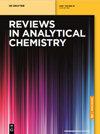Xanthene based resonance Rayleigh scattering and spectrofluorimetric probes for the determination of cyclobenzaprine: Application to content uniformity test
IF 3.8
3区 化学
Q2 CHEMISTRY, ANALYTICAL
引用次数: 8
Abstract
Abstract In this work, a resonance Rayleigh scattering technique and a spectrofluorimetric technique were applied to the quantification of cyclobenzaprine through two validated methods. The suggested methods are based on a facile association complex formation between cyclobenzaprine and eosin Y reagent in the acidic medium. The resonance Rayleigh scattering method relied on the enhancement in the resonance Rayleigh scattering spectrum of eosin Y at 370 nm after the addition of cyclobenzaprine. On the other hand, the spectrofluorimetric quantification relied on the quenching effect of cyclobenzaprine on the fluorescence strength of the eosin Y reagent at 545 nm (excitation wavelength at 300 nm). The suggested methods were linear over the ranges of 0.07–1.75 μg/mL and 0.15–2.0 μg/mL with detection limit values of 0.023 μg/mL and 0.048 μg/mL for the resonance Rayleigh scattering method and the spectrofluorimetric method, respectively. All reaction conditions for cyclobenzaprine–eosin Y formation were experimentally evaluated and optimized. In addition, both methods were validated based on ICH rules. Furthermore, the developed methods were practically applied to the analysis of cyclobenzaprine in its commercial tablet dosage form with acceptable recoveries. Moreover, the content uniformity test of the commercial cyclobenzaprine tablets was successfully applied using the proposed spectroscopic methods based on USP rules.杂蒽共振瑞利散射荧光法测定环苯扎林:在含量均匀性试验中的应用
摘要本文采用共振瑞利散射技术和荧光光谱法对环苯扎林进行了定量分析。所建议的方法是基于环苯扎林和伊红Y试剂在酸性介质中形成的易缔合络合物。共振瑞利散射法依靠的是加入环苯扎林后,伊红Y在370 nm处的共振瑞利散射谱增强。另一方面,荧光光谱定量依赖于环苯扎林对伊红Y试剂在545 nm处(激发波长300 nm)荧光强度的猝灭作用。共振瑞利散射法和荧光法在0.07 ~ 1.75 μg/mL和0.15 ~ 2.0 μg/mL范围内呈线性关系,检出限分别为0.023 μg/mL和0.048 μg/mL。对环苯扎林-伊红Y生成的所有反应条件进行了实验评价和优化。此外,两种方法都基于ICH规则进行了验证。此外,所建立的方法可用于环苯扎林商业片剂的分析,回收率可接受。此外,根据USP规则,采用所建立的光谱方法对商品环苯扎林片的含量均匀性进行了测试。
本文章由计算机程序翻译,如有差异,请以英文原文为准。
求助全文
约1分钟内获得全文
求助全文
来源期刊

Reviews in Analytical Chemistry
化学-分析化学
CiteScore
7.50
自引率
0.00%
发文量
15
审稿时长
>12 weeks
期刊介绍:
Reviews in Analytical Chemistry publishes authoritative reviews by leading experts in the dynamic field of chemical analysis. The subjects can encompass all branches of modern analytical chemistry such as spectroscopy, chromatography, mass spectrometry, electrochemistry and trace analysis and their applications to areas such as environmental control, pharmaceutical industry, automation and other relevant areas. Review articles bring the expert up to date in a concise manner and provide researchers an overview of new techniques and methods.
 求助内容:
求助内容: 应助结果提醒方式:
应助结果提醒方式:


